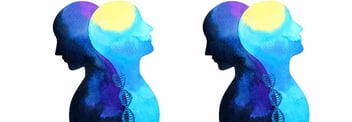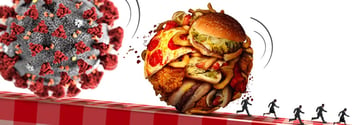Could Eye Movements Fight Pandemic PTSD in Orchids?
- Home
- Blog

Biohacking Your Mental Health Ecosystem: Part Five
Reader, in the comparatively rosy days before the pandemic hit, many of us shared a common complaint: We had too much to do, and too little time to do it. Ah, how the times have changed! Now, many of us find ourselves in the opposite position: with event calendars effectively cancelled, offices closed indefinitely, and fears mounting about the safety of gathering in public spaces like restaurants, the concept of “spare time” has gone from a precious commodity to a terrifying and ever-present reality. With scores of our population relegated to their homes, with nowhere to go in their downtime except their own minds, the words of Blaise Pascal ring true: “All of humanity’s problems stem from man’s inability to sit quietly in a room alone.” Sitting quietly is so scary for so many of us that we turn to the screen for comfort—“zoning out” is so much easier than “tuning in” to whatever might be emotionally haunting us—but too often we find there is no escaping those cobwebbed corners of our memories, our hopes and fears, our projections and our insecurities. Simply put, these are difficult times for all of us—but for some, they are downright emotionally unbearable.
More and more studies of this surreal era we now live in are pointing to ever-increasing mental health concerns among children and adults alike. But instead of just reporting the bad news, reader, I want to report to you some good news you can use right now to feel better. In this special blog, we’ll discuss how your genes might be playing a role in your psychological reaction to Covid-19 and we’ll hear from one of Potomac Psychiatry’s experts on a novel technique that could help you or your loved one overcome the undue burdens on your mental health. Let’s dive in together!
COVID-19, the SLC6A4 “Orchid Gene” and EMDR
If you’ve been following the news these last few months, it will come as no surprise that COVID-19 worries are directly correlated with higher rates of mental illness. What is surprising, however, is just how high those rates have become: in one study of young adults ages 18-30, 43.3% reported symptoms of depression, 45.4% reported feeling anxiety, and 31.8% exhibited signs of PTSD. These numbers are astronomical—and they are undoubtedly tied to the correspondingly high levels of loneliness participants reported during these trying days of social distancing and stay-at-home orders. In a previous blog, posted on our “Coping with COVID-19” webpage, we related certain COMT gene variants to higher rates of childhood PTSD. We configured coronavirus as a massive, invisible, global bully that is terrorizing children. Those kids with COMT Met/Met are more likely to develop PTSD and depression, and they also are less able to process and manage strong emotions in two important regions of the brain: the prefrontal cortex and the hippocampus. In that blog, we presented a promising type of therapy to help these kids—Trauma-Focused Cognitive Behavioral Therapy (TF-CBT). But what about adults? What makes some adults more vulnerable to coronavirus-bullying, and more likely to develop PTSD? And once we identify those at-risk, what are their treatment options?
To understand and treat adults suffering through these strange times, we must focus on a different gene, SLC6A4, and how it relates to stressful life events and adult PTSD. A total of 14 studies that included over 15,000 adults demonstrated that the “S” (short) allele of this gene predisposed adults to increased stress reactivity and PTSD, and related studies in animals demonstrated why. Associated with this short allele are increased hypothalamic-pituitary-adrenal axis activation (fight, flight or freeze reactions) in response to both physical and psychological stressors, along with changes in brain biochemistry. And as we know from prior blogs, the COVID-bully’s prolonged activation of this stress response causes us to crave carbohydrates and fats, which negatively affects our gut microbiome and weakens our immune system.
The SLC6A4 gene is assayed with Genomind’s Professional PGx test, as part of a panel of mental health genes that we use here at Potomac Psychiatry to optimize treatment outcomes.
So what’s an “SLC6A4 Orchid” with pandemic PTSD to do? Fortunately, my colleague Paulo Negro, MD, PhD, has some answers for us as a specialist in a type of therapy known as Eye Movement Desensitization and Reprocessing (EMDR). Dr. Negro tells Marcia’s story below to illustrate the power of EMDR—hopefully it will shed some light on how it could help you, too.
Marcia’s Story
Marcia is a 37-year-old patient who came to see us due to stress at work. She said that she was so anxious about her job that she was shaken speaking with her boss. She had meetings and felt short of breath when the attention was turned towards her. She had trouble sleeping, and even when she could sleep, it was not restful. She would replay scenes of the day and worry about the following morning. Nobody liked her boss at work. She wanted things her way and got angry if she believed that folks did not follow her orders. This stressful situation finally hit its breaking point when her coworkers, all scared of losing their jobs, decided to complain to HR together.
Predictably, her boss became furious. Although she knew that everyone was involved, she called Marcia to find out who were the actual ringleaders of the complaint. After Marcia refused to say anything, all the wrath became focused on her. It mattered not that COVID-19 made them all work from home—Marcia’s boss was implacable during meetings, yelling and belittling her for no reason. That was when Marcia’s anxiety got really bad. She became depressed and blamed herself for the problems. She thought that she should have been able to deal with these issues. Marcia was the youngest child of three siblings. Her father was never close to her, and her mother was critical. Her two older siblings did better at school than her. She was always an A-B student, but her siblings got straight As. Things at home became worse when the family went through financial difficulties and the father started to drink more. There was a lot of yelling at the house. Marcia always felt like she was walking on eggshells. It was like the family problems were all her fault. Deep inside she felt that she was never good enough. Sadly, she brought this childhood mentality with her well into her adult life. Her partner of five years seemed unhappy with their life together. Usually, she was ok with the criticisms at home, but once the problems at her office started, they, too, became unbearable. That’s when she decided to finally seek help.
Eye Movement Desensitization and Reprocessing: A Cure for the COVID Blues?
Marcia came to Potomac Psychiatry for an assessment of her anxiety and depression. We identified an anxiety disorder with secondary depressive symptoms. Although over the years she did ok, the bullying at her office played at topics sensitive to her heart. It activated her core belief of not being worthy. Her usual coping mechanisms of working hard did not work with her boss. She felt that she had never been able to deal with stress—and her genetic test results provided some clarity about this feeling. Her variance on her SLC6A4 gene—she had a single nucleotide polymorphism (SNP) showing S/S instead of L/L—made her less resilient to stress. She did not do well modulating difficult emotional states. In this situation, it is necessary to treat the underlying free-floating anxiety and depressive states with medications. It is also necessary to recognize how a history and repetition of traumatic experiences may need psychological intervention to desensitize against difficult feelings and thoughts as well as reprocess current emotional experiences in view of the emotional background.
After thoughtful discussion, she decided to be treated with the Eye Movement Desensitization and Reprocessing (EMDR) therapy. EMDR is a more experiential form of therapy that allows the patient to identify difficult current situations and process them while performing bilateral stimulation. Marcia started with the avoidance fears related to her boss bullying. Under bilateral stimulation she created for herself an inner resource of safety. In her case, she chose the memory of her grandmother, who was a loving, fearless woman. With this resource available, she faced her fears of her boss, and of showing anxiety in public. She connected these fears to old memories of her childhood. She already remembered these memories; they just came back with new connections with her current experiences. After EMDR treatment, Marcia felt strong enough to return to HR with a new complaint and even contemplate legal action. She has even started to question her core belief of not being worthy. There is still work that need to be done, but she is changing towards the right direction.
The Tools You Need to Cope with COVID
Reader, COVID-19 is introducing novel stressors in our lives, and—like Marcia—many of us are feeling more vulnerable than ever before. Whereas once we might bend under pressure before snapping back into place, now we are breaking from the weight of the collective trauma, difficulty, and uncertainty of the future. EMDR is an incredible therapeutic technique that has shown strong results in our practice, and when paired with the precision of genetic testing it can transform your mindset. Now is not the time to sit back and watch your mental health deteriorate—it’s the time to stand up and fight this COVID bully with whatever tools you and your trusted health professional have at your disposal.
Related Information
- Learn about Genetic Testing
- Learn about Potomac Psychiatry
- Meet Our Doctors
- Contact Potomac Psychiatry


